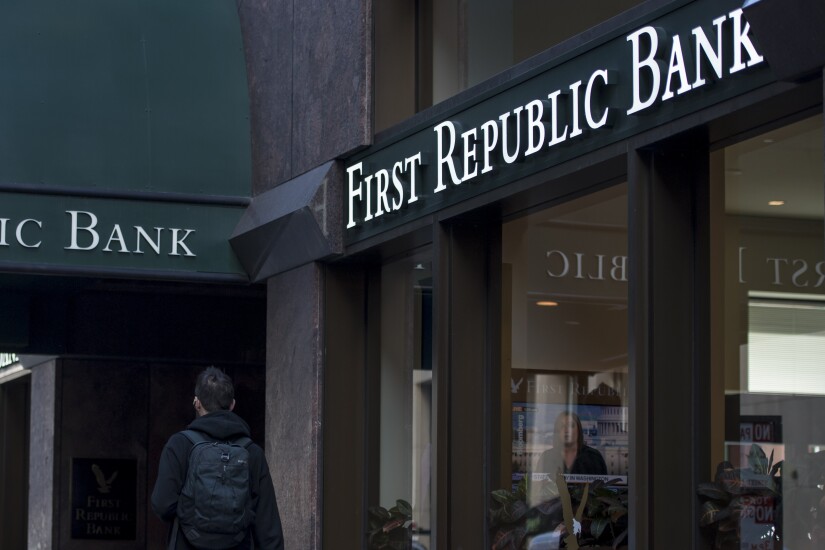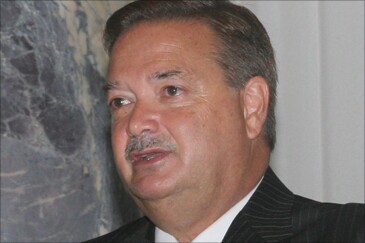
Short sellers like these banks
Some banks are bigger targets than others for a variety of reasons including their growth strategies, M&A appetite and overall risk profile. FIG Partners and S&P Global Market Intelligence recently conducted a study of publicly traded banks, highlighting 10 institutions with unusually high short-selling activity at Feb. 28.
For each institution flagged in the study, the short interest exceeded 5% of total outstanding shares at the end of February. The median level of short interest, or the number of shares sold “short” for the more than 125 banks in FIG Partners’ coverage, was 1.24%, which represented a decrease from 2.52% a year earlier.
American Banker recently spoke with Christopher Marinac, director of research at FIG Partners, to understand why certain investors are betting against these banks. Here is a look at those institutions, along with possible reasons for their short interest.

Banc of California
Banc of California’s new three-year plan, which it shared with investors in February, will involve a slow and deliberate turnaround. Meanwhile, the company
On the bright side for the bank, short interest in Banc of California is lower than it was three months ago.

Zions Bancorp.
Zions’ stock, which has largely stayed above $50 a share since November, has more than doubled since early 2016. Zions is among the three banks with the biggest increase in short interest over the last year as well as the past three months. What goes up must come down eventually, the short sellers presume.

New York Community Bancorp
Short interest was 8.7% of shares outstanding on Feb. 28.
The company has been intentionally keeping its assets below $50 billion to avoid being labeled a systemically important financial institution. Relief could be coming on that front if lawmakers can agree on a reform bill that would raise the SIFI threshold.

Glacier Bancorp
Glacier recently completed the purchase of Inter-Mountain Bancorp in Bozeman, Mont. At
Inter-Mountain was Glacier’s 20th bank acquisition since 2000, or an average of just over a deal each year. To keep up that pace, the company could very well be lining up its next purchase.

Bank of the Ozarks
CEO George Gleason has repeatedly expressed confidence in the company’s handling of CRE lending, pointing to its underwriting prowess. Bank of the Ozarks has charged off only a small handful of CRE loans over the past decade — and none since 2011.

Seacoast Banking Corp. of Florida
Its short interest, which is equal to nearly 6% of shares outstanding, could be tied to frustration that the company is determined to remain independent, Marinac said. The theory is that Seacoast shares could slide if many shareholders conclude that management and the board have no interest in finding a buyer anytime soon. In fact, Seacoast

First Republic Bank
While much of the added costs were tied to investments and marketing efforts, short sellers are likely hoping First Republic will again fall short of expectations in the first quarter, Marinac said.
The company has the second-highest increase in short interest over the past three months, trailing only Seacoast. At Feb. 28, short interest was equal to about 6% of shares outstanding.

Prosperity Bancshares
Marinac points to another reason: The M&A inclinations of CEO David Zalman. Under his leadership, the company developed a reputation as a prolific acquirer, buying eight banks after the financial crisis. Prosperity has been quiet recently; its last deal closed in January 2016.
Again, short sellers like to zero in on banks that they think will take a hit with a highly dilutive deal. At the end of February, short interest was equal to 5.5% of outstanding shares.

Sterling Bancorp
Now Sterling CEO Jack Kopnisky must master a

CVB Financial
It is also expected to take five years to earn back the acquisition’s 11% dilution to CVB’s tangible book value. That period could test the patience of investors, particularly those who believe the company could pursue more deals in the not-so-distant future, Marinac said.
Short interest in CVB was equal to 5.1% of shares outstanding at the end of February.





